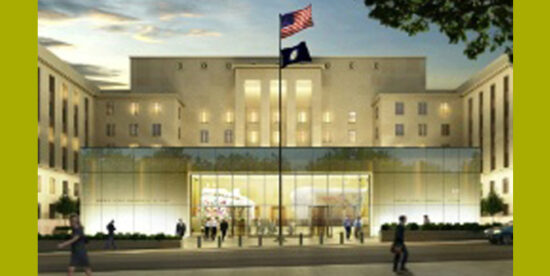
Washington, DC is the epicenter of U.S. government and foreign affairs and home to some of the most renowned museums in the world (over 76, according to Wikipedia). But despite that fact, there are no monuments or museums devoted to diplomacy, the art of foreign relations in the United States. But that is about to change. We visited the staff of the United States Diplomacy Center (USDC), currently under construction, to learn more. Global Ties U.S. spoke to USDC Director Kathy Johnson; and Senior Advisors Olive Sampson and Judith Bryan.
What is special about the United Stated Diplomacy Center?
United States Diplomacy Center: The USDC will fill the need for a place to educate, inform and engage citizens about the history of American diplomacy. The role of diplomacy in world events is often unknown, misunderstood or underappreciated by the many Americans who benefit from diplomacy in improved security and quality of life. Diplomacy serves the nation and its citizens, shaped America’s history, and will determine our role in the world into the future. As former Secretary of State Colin Powell has pointed out, there are hundreds of monuments and museums across the country related to our military history. This will be the first museum in the country devoted to diplomacy.
What will you have on display?
USDC: A wide array of exhibits will reflect our country’s significant role in world affairs. Visitors will see the gifts our Secretaries of State received when they traveled abroad. We will display artifacts, memorabilia and “tools of the trade” owned by former and current diplomats and their families. The USDC collection contains over 6,000 artifacts.
The USDC will guide visitors through a timeline of our nation’s diplomatic history, illustrating how it has shaped our lives today. Through an “embassy wall,” visitors also learn about the ways embassies work for our country. They will explore how diplomacy matters by discovering the worldwide reach of American diplomacy through an interactive world map and activities that will show, among other things, how diplomatic engagements affect their home state.
a timeline of our nation’s diplomatic history, illustrating how it has shaped our lives today
Diplomacy is a dangerous job. A lot of diplomats have been killed and incidents like the Iranian takeover of our embassy in Tehran left an indelible mark on America’s memory. How will you deal with this?
USDC: We are very mindful of the sacrifices our colleagues have made, there and elsewhere. We will have on display one of the blindfolds worn by a diplomat held hostage by the Iranians. One section of the Center will show the dangers and difficulties our diplomats face as they serve U.S. interests in challenging locations. A memorial wall will also commemorate those who lost their lives in diplomatic service to our country.
Who is building the museum?
USDC: As part of the Diplomacy Center’s public-private partnership, the Diplomacy Center Foundation has already raised US$38 million for the project. The construction of the museum and the fabrication of the exhibits are being paid exclusively through private donations. Efforts are ongoing to raise additional funds from the private sector for the project through a private capital campaign.
How big will the United States Diplomacy Center be?
USDC: Its three halls and mezzanine will cover 40,000 square feet. One hall will be devoted to the activities in which American diplomats are engaged now, protecting peace, promoting democracy, prosperity and development around the world, and why this matters to Americans. A corner will feature the current Secretary of State and the State Department’s policy priorities. A second hall will focus on the history of U.S. relations with the world. The third hall will be devoted to educational programs where visitors can listen to guest speakers and student groups can participate in diplomatic simulations. We will also pay tribute to the Americans across the country who are involved in citizen diplomacy, for example through Sister Cities exchanges and who are participating in their hometowns’ international activities.
How will you use technology?
USDC: We are planning a number of interactive displays allowing visitors to learn, including one about the relationships between each U.S. state and the world. For example, if you are from Kansas, you can touch an image of your state on a map and learn about the impact of its international relationships, through trade and educational exchange and more. We will also have a theater for films and a soundscape with people telling their diplomacy stories.
We will also pay tribute to the Americans across the country who are involved in citizen diplomacy
Will you do anything educational?
USDC: The educational community is a natural audience for USDC. Our educational activities will include an introduction to the art of negotiation, a glass-enclosed classroom for diplomatic simulations, and education stations for in-depth study of current issues. These will allow students to simulate, for example, the role of diplomats negotiating international agreements; resolving crises; managing an embassy; or assisting Americans in trouble abroad. U.S. diplomats who have actually done these things will plan these role-play simulations and lead teams carrying them out.
When will the United States Public Diplomacy Center open, and where is it?
USDC: Construction is underway, and we estimate sometime in the year 2016. The USDC’s proximity to the National Mall will make it easy for tourists to include a visit to the Center. The museum will be housed in the State Department Harry S. Truman headquarters building, which is located near public transportation stations and only two blocks away from monuments on the National Mall.
